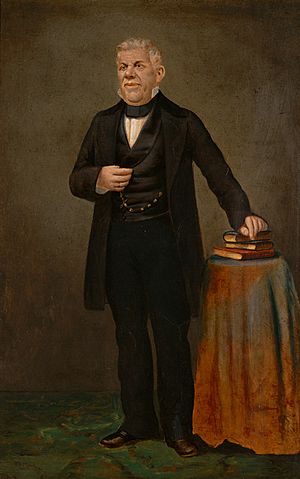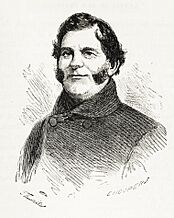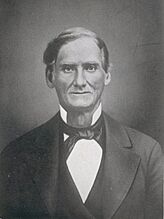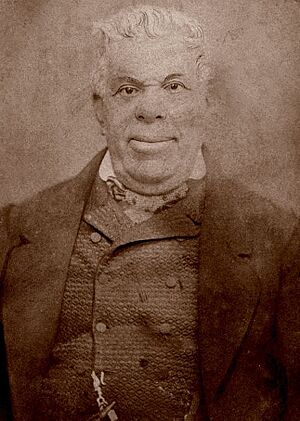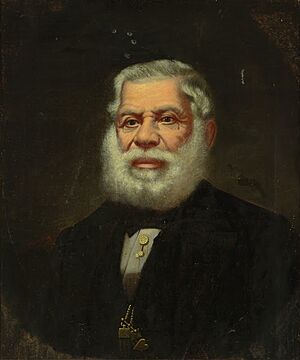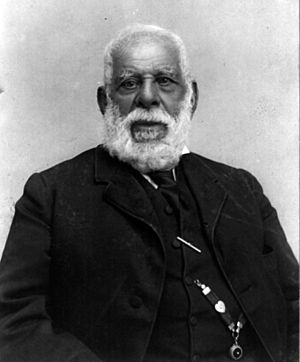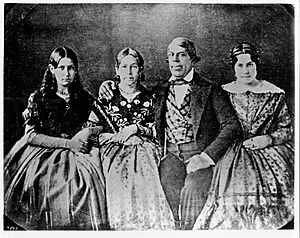Pío Pico facts for kids
Quick facts for kids
Pío Pico
|
|
|---|---|
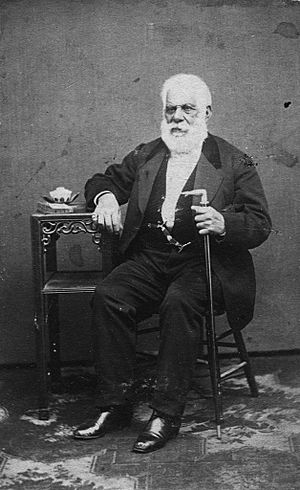
Pío Pico, c. 1890
|
|
| 10th Governor of California | |
| In office 22 February 1845 – 10 August 1846 |
|
| Preceded by | Manuel Micheltorena |
| Succeeded by | John Drake Sloat (As the U.S. Military Governor of California) |
| Los Angeles Common Councilman | |
| In office 1853–1853 |
|
| Personal details | |
| Born | May 5, 1801 Mission San Gabriel Arcángel San Gabriel, Alta California, New Spain |
| Died | September 11, 1894 (aged 93) Los Angeles, California, U.S. |
| Spouse | María Ignacia Alvarado |
| Relations | Andrés Pico |
| Profession | Entrepreneur, politician |
Don Pío de Jesús Pico (May 5, 1801 – September 11, 1894) was an important leader in California. He was a Californio (a person of Spanish descent born in California), a ranchero (a large ranch owner), and a businessman. He is most famous for being the last governor of California when it was still under Mexican rule.
Pío Pico was part of the well-known Pico family of California. He was one of the richest and most powerful people in California during his time. Many places are named after him today. These include the city of Pico Rivera, Pico Boulevard in Los Angeles, and Pio Pico State Historic Park.
Contents
Pío Pico's Early Life
Pío de Jesús Pico IV was born on May 5, 1801, at Mission San Gabriel Arcángel. He was the fourth of ten children born to José María Pico and María Eustaquia Gutiérrez. His younger brother, Andrés Pico, also became a famous general.
In 1805, Pío's family moved to San Diego. His father worked as a guard for missions, so the family moved often. Pío grew up near Mission San Diego de Alcalá. He had a simple education there. He learned to read from his brother-in-law, José Antonio Carrillo. Being able to read was very important for his future in politics.
Pío's father and other guards protected the missions from local Native Californians. These groups were unhappy about being forced to change their way of life. In 1819, Pío's father died, leaving Pío in charge of his large family.
Mexico Becomes Independent
Around 1820, Pico moved back to San Diego. He became a merchant, selling many different goods. This job allowed him to travel and meet important Californio families. His sisters married into these families, which helped Pico's political career.
In 1821, Mexico won its independence from Spain. After some changes, the First Mexican Republic was created. Two main groups formed: Liberals and Centralists. Liberals wanted states to share power with the government. Centralists wanted a strong central government. California mostly supported the Liberals.
Pico became a secretary to a captain. He sided with a merchant against military rule, which showed his support for liberal ideas. This was his first big political moment. He also supported California's liberal governor, José María de Echeandía. Echeandía wanted to release Native Americans from church control and give them land.
Pico's First Steps in Politics
Becoming a Diputado
Pico used his family connections to enter politics. By 1826, he was on San Diego's town council. In 1828, he was elected to California's legislative body, called a diputación. In 1829, Governor Echeandía gave Pico his first large piece of land, Rancho Jamul. Pico started raising cattle there and became a wealthy landowner.
By 1831, Pico was the most senior member of the diputación. A new conservative governor, Manuel Victoria, arrived. Victoria did not like Echeandía's plans to give land to Native Americans. He also ignored the diputación's requests and even suspended it. Victoria replaced civilian leaders with military ones. He also sent away people who spoke against his policies.
Pico wrote a strong response to Victoria. He said the diputación had the right to go against the governor. He presented himself as a patriot fighting for the freedom of citizens. His important position made his message powerful. Pico learned that Victoria planned to harm him and others. So, Pico gathered influential people from Southern California to plan a revolt.
The 1831 Revolt
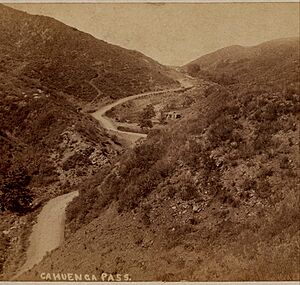
On November 29, 1831, Pico and his allies declared their rebellion against Victoria. They accused Victoria of breaking the law and making illegal arrests. They announced that Victoria was no longer governor. The next day, Pico and 15 armed men marched into San Diego. They arrested officials and took artillery. Soldiers from the garrison joined them.
They then went to Los Angeles, where they freed prisoners and arrested the local mayor. The rebellion gained public support. Governor Echeandía agreed to lead the rebels, which made their cause even stronger. In early December, Echeandía led about 50 men into Los Angeles.
Victoria's force of about 30 men met Pico and Echeandía's 150 men at Cahuenga Pass. The battle was short. Victoria was badly wounded and surrendered the next day. The rebels celebrated their victory.
Pico's First Time as Governor
A Brief Term
After Victoria left, the diputación met in Los Angeles. They chose Pico as the new governor on January 27, 1832. San Diego supported Pico's leadership.
However, Echeandía believed he was still the rightful governor. He said that Victoria had given the office to him before leaving. Echeandía threatened Pico and the diputación. To avoid more conflict, Pico stepped down. Echeandía then became governor on February 18.
Some historians disagree on whether Pico's first time as governor was official. But many agree that he held the position briefly between Victoria and the next governor.
What Happened Next
Soon after Pico resigned, another revolt started in Northern California. This revolt was led by Agustín V. Zamorano, Victoria's secretary. Pico worked to keep the peace and asked towns not to join Zamorano's revolt. Eventually, Zamorano and Echeandía agreed to share military control of California.
The federal government then sent a new governor, José Figueroa, who arrived in January 1833. Figueroa reunited the state under one leader.
Pico's Life Between Governorships
Land and Marriage
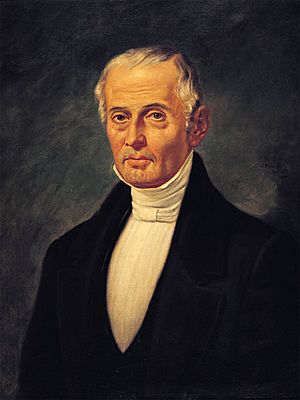
Governor Figueroa did not want to fully give away all church lands. He thought it would harm California's economy. But in 1833, a new liberal government in Mexico, led by Valentín Gómez Farías, ordered all missions to be secularized. This meant releasing Native Americans from church control and giving them land. Figueroa followed the order.
Pico married María Ignacia Alvarado on February 24, 1834. The wedding reception lasted eight days! Governor Figueroa was Pico's best man, showing their strong friendship. In 1837, Pico became the godfather to Juan Forster, an English immigrant who became a Mexican citizen. Forster later married Pico's sister, making them family.
Mission San Luis Rey and Challenges
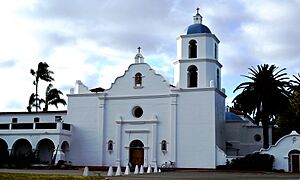
In 1835, Pico became the administrator of Mission San Luis Rey de Francia. Native Americans at the mission were unhappy with their treatment after secularization. Pico was very strict with them. He made them remove their hats when he passed by and let his cattle graze on their lands. He also tried to make money from the mission.
The Native Americans at San Luis Rey, called Luiseños, disliked Pico. They tried to get him removed, but Pico used military help to keep control. He even had a Luiseño leader arrested. However, large protests from the Luiseños forced Pico to release him.
In 1836, a conservative government took control in Mexico. Juan Bautista Alvarado, a politician from Northern California, led a revolt and declared California independent. Pico and other Southern California leaders did not agree with Alvarado. They supported another leader, Carlos Antonio Carrillo. In 1838, Alvarado's army defeated the southern rebels. Pico was briefly put in prison.
While Pico was in prison, Native Americans attacked and burned his Rancho Jamul. After his release, Pico worked to rebuild his ranches with his family's help. He was eventually removed from his role at Mission San Luis Rey in 1840.
Moving to Los Angeles
Pico then bought a home in Los Angeles Plaza. Los Angeles was a city where many wealthy ranch owners lived. In 1840, Pico tried to get more land. He was given Rancho Santa Margarita y Las Flores. His ranches were doing well, and he became very rich.
Pico did not directly join politics for a few years, but he was still influential. He argued that Los Angeles should be the capital of California, not Monterey. In 1840, he also worked as a tax collector for Los Angeles, which helped him meet many people in the city. Because of his wealth and the importance of ranching, Pico became one of the most respected people in Los Angeles.
In 1844, Pico bought Las Flores and shared it with his brother Andrés. They built a house there for guests and business. Pico's herds grew, and his ranches made him very wealthy.
Pico's Second Time as Governor
Returning to Power
In 1842, a new governor, Manuel Micheltorena, was sent to California from Mexico. Micheltorena brought an army of soldiers who caused problems for the local people. Many Californians, including Pico, did not trust Micheltorena.
In 1844, Pico was chosen as a leader in the California Assembly. In 1845, he was appointed governor again, replacing the unpopular Micheltorena. This happened because Micheltorena's soldiers were causing trouble and taking food from people's homes. This made Californians very angry.
Juan Bautista Alvarado organized a rebellion against Micheltorena. Micheltorena asked John Sutter to lead troops against the rebels. The two sides met in Cahuenga Pass, near Los Angeles. The battle was mostly an artillery fight. Many soldiers on both sides were immigrants from the United States. They realized they had no reason to fight each other. They united, left Micheltorena's side, and even captured Sutter. Micheltorena was defeated, and Pico became governor again.
The Mexican-American War
Pico made Los Angeles the new capital of California. In the year before the Mexican–American War, Pico thought California should become independent from Mexico and be protected by Britain.
When U.S. troops took over Los Angeles and San Diego in 1846 during the Mexican-American War, Pico fled to Mexico. He wanted to ask the Mexican government to send troops to defend California. He did not return to Los Angeles until after the war ended. He sadly accepted that California was now part of the United States.
Back in California
Pico automatically became a United States citizen. In 1853, he was elected to the Los Angeles Common Council, a local government group, but he did not take office. Pico also helped start the California Republican Party. He joined the larger Republican Party because he was against slavery.
Pico's Business Ventures
By the 1850s, Pico was one of the richest men in California. In 1850, he bought Rancho Paso de Bartolo, a large ranch that included part of what is now Whittier. He built a home there and lived in it until 1892. This home is now Pio Pico State Historic Park. Pico also owned other large ranches, totaling over 500,000 acres.
In 1868, he built the Pico House (Casa de Pico) in Los Angeles. It was a three-story, 33-room hotel. When it opened in 1869, it was the most luxurious hotel in Southern California. Today, the Pico House is part of the El Pueblo de Los Angeles State Historic Monument. It is sometimes used for exhibits and special events.
Pico's Later Years
After California became part of the United States, Pico focused on his businesses. He was one of the wealthiest cattle owners in California. He owned more than a quarter million acres of land. He had to fight over 100 legal cases to protect his wealth.
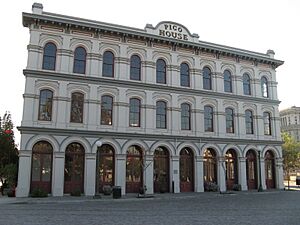
However, Pico lost his money due to gambling, bad business choices, and being tricked by others. A big flood in 1883 also hurt him financially. He was forced to sell his lands. His last years were spent in poverty.
In 1893, some history fans asked him to appear at a big event in Chicago. They wanted him to be shown as "the last of the California 'dons'." Pico refused, as he felt it was disrespectful. He died in 1894 at his daughter's home in Los Angeles. He was buried in El Campo Santo Cemetery in the City of Industry.
Pico's Personal Life
Pico's wife, María Ignacia Alvarado, died in 1854. Pico never said he had any children, but some people claimed to be his direct descendants. The mixed martial artist Aaron Pico is reportedly a distant relative.
Pico spoke Spanish and never learned English. This became a problem for him in some of his legal cases. During his life, Pico was a citizen of three different countries: Spain, Mexico, and the United States. He was known for his fancy lifestyle, with nice clothes and expensive furniture. He also enjoyed gambling a lot.
Pico's Legacy
Many places and streets are named after Pío Pico, especially in Southern California. Pico Boulevard, a major street in Los Angeles, is named for him. The Los Angeles neighborhoods of Pico Union and Pico-Robertson also bear his name. The city of Pico Rivera is named after him too. There are also train stops called Pico station and Pico/Aliso station.
Pío Pico State Historic Park is the historic site of Governor Pico's ranch and adobe mansion. It is located in Whittier, California, and is open to the public. The Pico House, his historic hotel in Downtown Los Angeles, is now part of a historical monument.
See also
 In Spanish: Pío de Jesús Pico para niños
In Spanish: Pío de Jesús Pico para niños


